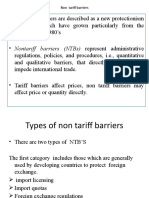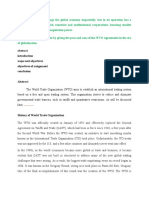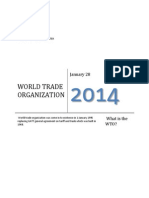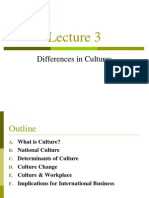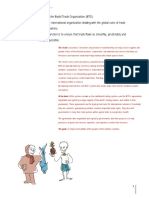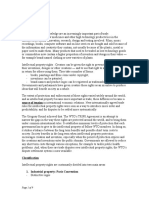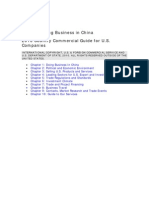Summary Notes WTO SPS and TBT
Summary Notes WTO SPS and TBT
Uploaded by
dorudascCopyright:
Available Formats
Summary Notes WTO SPS and TBT
Summary Notes WTO SPS and TBT
Uploaded by
dorudascOriginal Description:
Original Title
Copyright
Available Formats
Share this document
Did you find this document useful?
Is this content inappropriate?
Copyright:
Available Formats
Summary Notes WTO SPS and TBT
Summary Notes WTO SPS and TBT
Uploaded by
dorudascCopyright:
Available Formats
Chapter 14 SPS and TBT
Summary/ compilation SPS and TBT
TBT and SPS
Notes/Summary based on the International Trade Book, WTO website and the WTO
Academy
Section 14.1 Introduction
- Overview of the problems associated with technical regulations and product
standards
- Discussion of why the use of such measures for protectionist purposes may be a
particularly worrisome type of practice
Idea (WTO website):
- All countries maintain measures to ensure that food is safe for consumers, and to
prevent the spread of pests or diseases among animals and plants.
- These sanitary and phytosanitary measures can take many forms, such as
o requiring products to come from a disease-free area,
o inspection of products,
o specific treatment or processing of products,
o setting of allowable maximum levels of pesticide residues or permitted use
of only certain additives in food.
- Sanitary (human and animal health) and phytosanitary (plant health) measures
apply to domestically produced food or local animal and plant diseases, as well as
to products coming from other countries.
Protectionism: Sanitary and phytosanitary measures, by their very nature, may result in
restrictions on trade.
-
All governments accept the fact that some trade restrictions may be necessary to
ensure food safety and animal and plant health protection.
However, governments are sometimes pressured to go beyond what is needed for
health protection and to use sanitary and phytosanitary restrictions to shield
domestic producers from economic competition.
Such pressure is likely to increase as other trade barriers are reduced as a result of
the Uruguay Round agreements.
A sanitary or phytosanitary restriction which is not actually required for health
reasons can be a very effective protectionist device, and because of its technical
complexity, a particularly deceptive and difficult barrier to challenge.
The Agreement on Sanitary and Phytosanitary Measures (SPS) builds on previous
GATT rules to restrict the use of unjustified sanitary and phytosanitary measures
for the purpose of trade protection.
The basic aim of the SPS Agreement is to maintain the sovereign right of any
government to provide the level of health protection it deems appropriate, but to
ensure that these sovereign rights are not misused for protectionist purposes and
Page 1 of 10
Chapter 14 SPS and TBT
do not result in unnecessary barriers to international trade.
Section 14.2 : The SPS Agreement
Idea:
- One of the major goals of the Uruguay Round (UR) was to bring agricultural trade
back within the GATT disciplines.
- Among the non-tariff barriers that concerned negotiators were measures
ostensibly taken for sanitary and phytosanitary (SPS) purposes
General Issues
The SPS is the most important agreement covering international trade in food and
agricultural products
It was not opened for renegotiation
It was assumed that the UR would bring substantial improvements in agricultural
market opening, through lowering tariffs and removing quotas.
There was concern that with the new market opening, countries would find new
ways of blocking agriculture.
SPS is an elaboration of the rules of GATT 1994, in particular article XX(b)
SPS
Food safety, animal health and plant health
The basic objective of the SPS is to prohibit unjustified health-related barriers to
agricultural trade.
The SPS does NOT cover issues related to the quality of agricultural products.
Health-related issues not quality-related which is normally covered by the TBT.
The SPS applies only to agricultural products imported from other WTO member
countries.
It does not apply to domestic laws and regulation that do not have an impact on
international trade. Pure domestic situations are not covered by SPS
However, domestic regulations must not have the effect of discriminating against
imported products.
Basic Obligation (article 2)
1. Applied to the extent necessary to protect human, animal and plant
2. Based on scientific principles and
3. Not maintained without sufficient scientific evidence.
The main obligations put forth in the SPS in a nutshell:
- Article 2(1) recognizes the right of WTO members to take SPS measures
necessary to protect life and/or health
- Article 2(2) requires WTO members to apply such measures only to the extent
necessary to protect life or health, to base the measures on scientific principles
and not to maintain them without scientific evidence
Page 2 of 10
Chapter 14 SPS and TBT
Article 2(3) requires that SPS measures do not arbitrarily or unjustifiably
discriminate between WTO members where similar or identical conditions apply
and not to be applied in a manner that constitutes a disguised restriction in
international trade.
Article 3(1) requires the WTO members to base their SPS measures on
international standards where they exist
Article 3(3) allows WTO members to introduce SPS measures that result in a
higher level of protection that would be achieved by measures based on
international standards, so long they are scientifically justified, i.e. based on a risk
assessment conducted pursuant to article 5 of the agreement.
Harmonization (article 3)
o Important differences between shall and should. The SPS Agreement
promotes harmonization, but does not require it.
o WTO members shall base their SPS measure on international standards,
guidelines or recommendation, where they exist
o Stricter (than international) SPS measures are allowed:
If there is a scientific justification; or
If the member determines that a higher level of protection is
appropriate (this is a sovereign right to set their acceptable level of
risk)
International Standards the 3 sisters become stars!
o Codex Alimentarius Commission (Codex)
o World Organization for Animal Health (OIE)
o International Plant Protection convention (IPPC)
Equivalence (article 4)
o SPS measures of an exporting country shall be accepted, even if they are
different from the measures required by the importing country, if they
achieve the importing countrys level of protection.
Assessment of risk (article 5)
o SPS measures must be based on an assessment of the risks to human,
animal or plant life
o WTO members shall take into account available scientific evidence and
risk assessment techniques developed by the relevant international
organization among other factors.
Appropriate level of SPS protection
The SPS agreement recognized the right of each WTO member to determine its
own appropriate level of protection. However, this should be done with
o The objective of achieving consistency and
o The objective of minimizing negative trade effects
o Example: if a country decides to ban apples because they want more safety
in apples but on the other hand the country is taking large risk in citric
Page 3 of 10
Chapter 14 SPS and TBT
could make no sense. The only reason could be discriminate and protect
national industry.
Provisional measures (article 5.7)
o If scientific information is insufficient, a WTO member may provisionally
adopt SPS measures on the basis of available information.
o The member shall seek additional information and review the measure
within a reasonable period of time.
o This is the precautionary principle. Members are allowed to take
provisional measures because of the imminent risk, but the country is
blocking trade, so it has to be for short time.
Provisional measure (cont)
o This was not an issue that was discussed in the negotiations. The
Europeans brought it who knows how.
o Precautionary principle should not be viewed as an interpretation of the
provision in 5.7
o The disagreements on this issue between the US and the EU stem in part
from cultural and philosophical differences in the approach to risk
managements
Pest- or Disease-Free Areas (article 6)
o Import measures shall be adjusted to the SPS characteristics of the area
from which a product is exported, even if the region is only part of the
exporting country.
o In assessing the exporting region, relevant factors include the prevalence
of specific diseases or pests, the effectiveness of SPS controls, and other
factors.
o Example of potatoes from Maine and Idaho: Japan wanted to ban the
potatoes from whole US because the ones from Maine were affected from
a disease. Nevertheless, US could justify that the distance between both
states (Maine and Idaho) ensure that the disease did not affect potatoes
from Idaho.
Procedures for control and approval (annex C)
o The SPS has numerous requirements for control procedures used to check
whether SPS measures are being fulfilled, especially approval procedures.
o Approval procedures should be:
Science-based
Transparent
Completed without undue delay
Special and Differential Treatment
o Because the SPS agreement has the objective of protecting health, the
incorporation of S&D treatment was significantly limited.
o S&D treatment in the SPS agreement was essentially limited to:
Encouragement of technical assistance
Page 4 of 10
Chapter 14 SPS and TBT
Possibly more time for developing countries to implement their
own import requirements
o The idea of the special treatment is not to provide more time to developing
countries to reduce tariff, or to allow a lower level of protection because
the goods are coming from developing countries.
The Beef Hormones Case
The US EU beef hormones dispute was one of the first SPS case
The legal outcome hinged on a WTO finding that the EU did not conduct an
adequate risk assessment
The cases long evolution includes retaliation and compensation and it continues
to this day.
US was allowed to retaliate. The EU allow a quota of US hormone-free beef, but
it did not change the legislation, so this case is considered to be still open.
Summary WTO website
-
Measure at issue: EC prohibition on the placing on the market and the importation
of meat and meat products treated with certain hormones.
Products at issue: Meat and meat products treated with hormones for growth
purposes.
Key findings Risk assessment
Risk assessment
SPS Art. 5.1:
- Panels ultimate conclusion was that the EC measure violated Art. 5.1 (and thus
Art. 3.3) because it was not based on a risk assessment
- the Appellate Body upheld the conclusion, but reversed the Panel's interpretation,
considering that Art. 5.1 requires that there be a "rational relationship" between
the measure at issue and the risk assessment.
- Idea: first, the scientific reports referred to by the EC do not rationally support the
EC import prohibition; second, the EC did not proceed to an assessment of the
risks arising from the failure of observance of good veterinary practices.
- Conclusion: the EC import prohibition is not based on a risk assessment within
the meaning of Articles 5.1 and 5.2 of the SPS Agreement and is therefore
inconsistent with Article 5.1.
Biotechnology
The SPS does not specifically mention agricultural biotechnology (GMOs)
However, the rights and obligations of the SPS agreement do fully apply to the
issues of biotech
In the regulation of agricultural biotech must be consistent with the SPS
This application was confirmed by the WTO in the US-EU case
Page 5 of 10
Chapter 14 SPS and TBT
Primary ruling: the WTO found that the EU moratorium on biotech approvals led
to undue delay. Thus, what it looked to be not important, the period of time for
approvals, in the biotech field turned to be critical.
Summary WTO website (+book pages 668 669)
EC APPROVAL AND MARKETING OF BIOTECH PRODUCTS (DS291, 292, 293)
Complainants: United States, Canada, Argentina
Measures at issue: (i) Alleged general EC moratorium on approvals of biotech products;
(ii) EC measures allegedly affecting the approval of specific biotech products; and (iii)
EC member State safeguard measures prohibiting the import/marketing of specific
biotech products within the territories of these member States.
Products at issue: Agricultural biotech products (GMOs) from the United States, Canada
and Argentina.
Summary of key panel/AB findings
General EC moratorium
Existence of moratorium: The Panel found that a general de facto moratorium on
approvals of biotech products was in effect on the date of panel establishment, i.e.,
August 2003. It was general in that it applied to all applications for approval pending in
August 2003 under the relevant EC legislation, and de facto because it had not been
formally adopted. Approvals were prevented through actions/omissions by a group of five
EC member States and/or the European Commission.
SPS Arts. 5.1 and 2.2: The Panel found that the EC decision to apply a general
moratorium was a decision concerning the application/operation of approval procedures,
i.e., a procedural decision to delay final substantive approval decisions. It was not applied
for achieving the EC level of sanitary or phytosanitary protection and, hence, was not an
"SPS measure" subject to Arts. 5.1 or 2.2.
SPS Annex C(1)(a) and Art. 8: The Panel found that the general moratorium led to undue
delay in the completion of the EC approval procedure conducted in respect of at least one
biotech product at issue. Thus, European Communities acted inconsistently with Annex
C(1)(a) and, by implication, Art. 8. Product-specific measures
SPS Annex C(1)(a) and Art. 8: The Panel found that in 24 of the 27 product-specific
approval procedures it examined, the procedure had not been completed without undue
delay. In respect of these procedures, the European Communities had, therefore, acted
inconsistently with Annex C(1)(a) and, by implication, Art. 8.
EC member State safeguard measures
SPS Arts. 5.1, 2.2 and 5.7: According to the Panel, the record did not indicate that there
was insufficient evidence to conduct a risk assessment within the meaning of Art. 5.1 and
Page 6 of 10
Chapter 14 SPS and TBT
Annex A(4) for the biotech products subject to safeguard measures. As a result, Arts. 5.1
and 2.2 were applicable. In this regard, the Panel found that none of the safeguard
measures at issue were based on a risk assessment as required under Art. 5.1 and defined
in Annex A(4). By maintaining measures contrary to Art. 5.1, the European Communities
had, by implication, also acted inconsistently with Art. 2.2.
Broader Issues/ WTO notes
The issue of national sovereignty versus WTO membership perhaps raised most
often in connection with the SPS
The SPS has been seen as conflicting with the Cartagena Protocol on Biosafety.
Section 14.3 The Technical Trade Barriers
Idea: WTO website
- the number of technical regulations and standards adopted by countries has grown
significantly.
- increased regulatory policy can be seen as the result of higher standards of living
worldwide, which have boosted consumers' demand for safe and high-quality
products, and of growing problems of environment (water, air and soil pollution)
which have encouraged modern societies to explore environmentally-friendly
products.
- it is difficult to give a precise estimate of the impact on international trade of the
need to comply with different foreign technical regulations and standards, but it
certainly involves significant costs for producers and exporters.
- these costs arise from
o the translation of foreign regulations,
o hiring of technical experts to explain foreign regulations,
o adjustment of production facilities to comply with the requirements
o In addition, there is the need to prove that the exported product meets the
foreign regulations.
- The high costs involved may discourage manufacturers from trying to sell abroad.
- In the absence of international disciplines, a risk exists that technical regulations
and standards could be adopted and applied solely to protect domestic industries.
Technical regulations and standards in the TBT Agreement
- Technical regulations and standards set out specific characteristics of a product
such as its size, shape, design, functions and performance, or the way it is labelled
or packaged before it is put on sale.
- In certain cases, the way a product is produced can affect these characteristics,
and it may then prove more appropriate to draft technical regulations and
standards in terms of a product's process and production methods rather than its
characteristics per se. The TBT Agreement makes allowance for both approaches
in the way it defines technical regulations and standards (Annex 1).
Page 7 of 10
Chapter 14 SPS and TBT
Definitions: Annex 1 TBT
Technical regulation
Document which lays down product characteristics or their related processes and
production methods, including the applicable administrative provisions, with which
compliance is mandatory. It may also include or deal exclusively with terminology,
symbols, packaging, marking or labelling requirements as they apply to a product,
process or production method.
Standard
Document approved by a recognized body, that provides, for common and repeated use,
rules, guidelines or characteristics for products or related processes and production
methods, with which compliance is not mandatory. It may also include or deal
exclusively with terminology, symbols, packaging, marking or labelling requirements as
they apply to a product, process or production method.
Conformity assessment procedures
Any procedure used, directly or indirectly, to determine that relevant requirements in
technical regulations or standards are fulfilled.
Difference between a technical regulation and a standard:
- The difference between a standard and a technical regulation lies in compliance.
- While conformity with standards is voluntary, technical regulations are by nature
mandatory. They have different implications for international trade:
o If an imported product does not fulfil the requirements of a technical
regulation, it will not be allowed to be put on sale.
o In case of standards, non-complying imported products will be allowed on
the market, but then their market share may be affected if consumers'
prefer products that meet local standards such as quality or colour
standards for textiles and clothing.
TBT (WTO Notes)
Relationship between the TBT and GATT 1994 (artc. I and III of GATT 1994)
(article XX GATT 1994)
Major areas of TBT scope:
o Technical regulations
o Standards
o Conformity assessments
Article 2.2 is substantive core of TBT
Technical regulation shall not have effect of creating unnecessary obstacles to
international trade
It is not about the product itself, but about the environment where it is produced.
Dispute Settlement: COOL (country-of-origin-labeling)
o US require that cows must be grown, slaughtered and marketed in US to
be considered US product. Canada and Mexico challenged it.
Page 8 of 10
Chapter 14 SPS and TBT
Book: EC Trade description of Sardines
-
Peru requested consultations with the EC concerning Regulation (EEC) 2136/89
which prevented Peruvian exporters to continue to use the trade description
sardines for their products.
Peru submitted that, according to the relevant Codex Alimentarius standards
(STAN 94-181 rev. 1995), the species sardinops sagax sagax are listed among
those species which can be traded as sardines.
Peru, therefore, considered that the above Regulation constitutes an unjustifiable
barrier to trade, and, hence, in breach of Articles 2 and 12 of the TBT Agreement
and Article XI:1 of GATT 1994.
In addition, Peru argues that the Regulation is inconsistent with the principle of
non-discrimination, and, hence, in breach of Articles I and III of GATT 1994.
The Appellate Body:
upheld the Panels finding, in paragraph 7.35 of the Panel Report, that the EC
Regulation is a technical regulation under the TBT Agreement;
upheld the Panels findings, in paragraph 7.60 of the Panel Report, that Article 2.4 of
the TBT Agreement applies to measures that were adopted before 1 January 1995 but
which have not ceased to exist, and, in paragraph 7.83 of the Panel Report, that
Article 2.4 of the TBT Agreement applies to existing technical regulations, including
the EC Regulation;
upheld the Panels finding, in paragraph 7.70 of the Panel Report, that Codex Stan 94
is a relevant international standard under Article 2.4 of the TBT Agreement;
upheld the Panels finding, in paragraph 7.112 of the Panel Report, that Codex Stan 94
was not used as a basis for the EC Regulation within the meaning of Article 2.4 of
the TBT Agreement; EC said that there must be only a rational relationship between
a standard and a technical regulation.
reversed the Panels finding, in paragraph 7.52 of the Panel Report, that, under the
second part of Article 2.4 of the TBT Agreement, the burden of proof rested with the
EC to demonstrate that Codex Stan 94 is an ineffective or inappropriate means for the
fulfilment of the legitimate objectives pursued by the EC through the EC Regulation.
AB found, instead, that the burden of proof rested with Peru to demonstrate that Codex
Stan 94 is an effective and appropriate means to fulfil those legitimate objectives,
and, upheld the Panels finding, in paragraph 7.138 of the Panel Report, that Peru has
adduced sufficient evidence and legal arguments to demonstrate that Codex Stan 94 is
not ineffective or inappropriate to fulfil the legitimate objectives of the EC
Regulation;
rejected the claim of the EC that the Panel did not conduct an objective assessment of
the facts of the case, as required by Article 11 of the DSU;
TBT and SPS : conceptual similarities
Page 9 of 10
Chapter 14 SPS and TBT
The TBT and SPS hare some key concept
Legal scopes of the SPS and TBT do not overlap. SPS has precedence. If it is
confusing to know where a regulation falls, look at the health-related risk (SPS) or
non-related health risk (TBT)
Page 10 of 10
You might also like
- Top Ten Reasons To Oppose The WTO From Global Exchange100% (1)Top Ten Reasons To Oppose The WTO From Global Exchange2 pages
- Principles of Wto: 1. Trade Without DiscriminationNo ratings yetPrinciples of Wto: 1. Trade Without Discrimination6 pages
- General Agreement On Tariff and Trade and World Trade OrganisationNo ratings yetGeneral Agreement On Tariff and Trade and World Trade Organisation17 pages
- Sanitary and Phytosanitary Measures: Name:Vivasvan Gautam Roll No 902 Section C LLB 3 Years CourseNo ratings yetSanitary and Phytosanitary Measures: Name:Vivasvan Gautam Roll No 902 Section C LLB 3 Years Course11 pages
- Presented By: David D'Penha 33 Deepa Thakkar 34 Gayatri Das 48 Kunali Shah 69No ratings yetPresented By: David D'Penha 33 Deepa Thakkar 34 Gayatri Das 48 Kunali Shah 6921 pages
- The Political Economy of International TradeNo ratings yetThe Political Economy of International Trade29 pages
- Eighth Semester Ba LLB Paper Code: LLB 408 Subject: International Trade LawNo ratings yetEighth Semester Ba LLB Paper Code: LLB 408 Subject: International Trade Law59 pages
- International Trade:: Uruguay Round Agreements100% (1)International Trade:: Uruguay Round Agreements54 pages
- Special Features and Benefits of ICSID MembershipNo ratings yetSpecial Features and Benefits of ICSID Membership4 pages
- Agreement On Subsidies and Countervailing Measures 16022011100% (1)Agreement On Subsidies and Countervailing Measures 1602201132 pages
- World Trade Organisation: Functions of W.T.ONo ratings yetWorld Trade Organisation: Functions of W.T.O12 pages
- Challenges and Opportunities For Regional Integration in AfricaNo ratings yetChallenges and Opportunities For Regional Integration in Africa14 pages
- Fundamental Breach and The CISG - A Unique Treatment or Failed Experiment? Bruno ZellerNo ratings yetFundamental Breach and The CISG - A Unique Treatment or Failed Experiment? Bruno Zeller12 pages
- The World Trade Organization... The World Trade Organization..No ratings yetThe World Trade Organization... The World Trade Organization..7 pages
- Dispute Over Subsidies of Airbus and Boeing (WTO Dispute)No ratings yetDispute Over Subsidies of Airbus and Boeing (WTO Dispute)39 pages
- Non-Tariff Barriers: Major NTB's IdentifiedNo ratings yetNon-Tariff Barriers: Major NTB's Identified6 pages
- Translation of Environment Protection From The Area of Collective Rights To The Individual Human Rights (2005)No ratings yetTranslation of Environment Protection From The Area of Collective Rights To The Individual Human Rights (2005)20 pages
- The European Commission's Practice On Exporters Found Not To Dump in The Aftermath of WTO Mexico Rice - F D Dascalescu - JWT 44 6 - 2010No ratings yetThe European Commission's Practice On Exporters Found Not To Dump in The Aftermath of WTO Mexico Rice - F D Dascalescu - JWT 44 6 - 201020 pages
- EU Welcomes Conclusion of Negotiations On Russia's WTO AccessionNo ratings yetEU Welcomes Conclusion of Negotiations On Russia's WTO Accession2 pages
- EU and Russia Make Progress On WTO AccessionNo ratings yetEU and Russia Make Progress On WTO Accession1 page
- Summary WTO: Trade Defence Measures Safeguards SGNo ratings yetSummary WTO: Trade Defence Measures Safeguards SG8 pages
- European Union Factsheet - EU-RUSSIA SUMMIT: MEMO/10/649No ratings yetEuropean Union Factsheet - EU-RUSSIA SUMMIT: MEMO/10/6492 pages
- Summary GATT Article XX: General Exceptions100% (1)Summary GATT Article XX: General Exceptions6 pages
- Overview - Garments Industry in Bangladesh100% (1)Overview - Garments Industry in Bangladesh24 pages
- Treaty Interpretation Under The Vienna Convention On The Law of TreatiesNo ratings yetTreaty Interpretation Under The Vienna Convention On The Law of Treaties368 pages
- Instant Download Economics A Student S Guide 5th Edition John Beardshaw PDF All Chapter100% (9)Instant Download Economics A Student S Guide 5th Edition John Beardshaw PDF All Chapter84 pages
- JHJMCC_Answers_Clarification_Questions_23rd_editionNo ratings yetJHJMCC_Answers_Clarification_Questions_23rd_edition17 pages
- BUSINESS STUDIES 319 CLASS 12TH IN ENGLISH100% (1)BUSINESS STUDIES 319 CLASS 12TH IN ENGLISH83 pages
- Chapter 3 - Managing in A Global EnvironmentNo ratings yetChapter 3 - Managing in A Global Environment22 pages
- International Trade: Class-Xii Chapter-9 (Fundametaql of Human Geography) Question BankNo ratings yetInternational Trade: Class-Xii Chapter-9 (Fundametaql of Human Geography) Question Bank3 pages
- Transparency in World Trade OrganizationNo ratings yetTransparency in World Trade Organization8 pages
- Political Science For Masters - CompressedNo ratings yetPolitical Science For Masters - Compressed1,060 pages
- 2020:21 Unit 2 - The External Business EnvironmentNo ratings yet2020:21 Unit 2 - The External Business Environment28 pages
- Cambridge Applying - Wto - and - Fta - Disciplines - To - Data - Localization - MeasuresNo ratings yetCambridge Applying - Wto - and - Fta - Disciplines - To - Data - Localization - Measures29 pages
- Top Ten Reasons To Oppose The WTO From Global ExchangeTop Ten Reasons To Oppose The WTO From Global Exchange
- Principles of Wto: 1. Trade Without DiscriminationPrinciples of Wto: 1. Trade Without Discrimination
- General Agreement On Tariff and Trade and World Trade OrganisationGeneral Agreement On Tariff and Trade and World Trade Organisation
- Sanitary and Phytosanitary Measures: Name:Vivasvan Gautam Roll No 902 Section C LLB 3 Years CourseSanitary and Phytosanitary Measures: Name:Vivasvan Gautam Roll No 902 Section C LLB 3 Years Course
- Presented By: David D'Penha 33 Deepa Thakkar 34 Gayatri Das 48 Kunali Shah 69Presented By: David D'Penha 33 Deepa Thakkar 34 Gayatri Das 48 Kunali Shah 69
- Eighth Semester Ba LLB Paper Code: LLB 408 Subject: International Trade LawEighth Semester Ba LLB Paper Code: LLB 408 Subject: International Trade Law
- Agreement On Subsidies and Countervailing Measures 16022011Agreement On Subsidies and Countervailing Measures 16022011
- Challenges and Opportunities For Regional Integration in AfricaChallenges and Opportunities For Regional Integration in Africa
- Fundamental Breach and The CISG - A Unique Treatment or Failed Experiment? Bruno ZellerFundamental Breach and The CISG - A Unique Treatment or Failed Experiment? Bruno Zeller
- The World Trade Organization... The World Trade Organization..The World Trade Organization... The World Trade Organization..
- Dispute Over Subsidies of Airbus and Boeing (WTO Dispute)Dispute Over Subsidies of Airbus and Boeing (WTO Dispute)
- Translation of Environment Protection From The Area of Collective Rights To The Individual Human Rights (2005)Translation of Environment Protection From The Area of Collective Rights To The Individual Human Rights (2005)
- The European Commission's Practice On Exporters Found Not To Dump in The Aftermath of WTO Mexico Rice - F D Dascalescu - JWT 44 6 - 2010The European Commission's Practice On Exporters Found Not To Dump in The Aftermath of WTO Mexico Rice - F D Dascalescu - JWT 44 6 - 2010
- EU Welcomes Conclusion of Negotiations On Russia's WTO AccessionEU Welcomes Conclusion of Negotiations On Russia's WTO Accession
- European Union Factsheet - EU-RUSSIA SUMMIT: MEMO/10/649European Union Factsheet - EU-RUSSIA SUMMIT: MEMO/10/649
- Treaty Interpretation Under The Vienna Convention On The Law of TreatiesTreaty Interpretation Under The Vienna Convention On The Law of Treaties
- Instant Download Economics A Student S Guide 5th Edition John Beardshaw PDF All ChapterInstant Download Economics A Student S Guide 5th Edition John Beardshaw PDF All Chapter
- JHJMCC_Answers_Clarification_Questions_23rd_editionJHJMCC_Answers_Clarification_Questions_23rd_edition
- International Trade: Class-Xii Chapter-9 (Fundametaql of Human Geography) Question BankInternational Trade: Class-Xii Chapter-9 (Fundametaql of Human Geography) Question Bank
- 2020:21 Unit 2 - The External Business Environment2020:21 Unit 2 - The External Business Environment
- Cambridge Applying - Wto - and - Fta - Disciplines - To - Data - Localization - MeasuresCambridge Applying - Wto - and - Fta - Disciplines - To - Data - Localization - Measures
